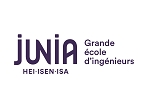Establishment
Language of instruction
French, English
Teaching content
MB-ST
Training officer(s)
C.DELERUE, B.GRANDIDIER
Stakeholder(s)
C.DELERUE, I.LEFEBVRE, B.GRANDIDIER, V.SENEZ, JF.ROBILLARD, Stéphane LENFANT
Présentation
Prerequisite
Classical mechanics, electrostatics and magnetism in condensed matter, electromagnetism, ray optics, notions in chemistry.
Goal
Science and engineering of functional materials play a key role in the development of information and communication technologies, bio- and nano-technologies. The remarkable advancements in these domains rely on an increasing number of materials like metals, semiconductors, oxides, ceramics, organic polymers, and bio-materials, as found for example in mobile phones. The functions designed in these technologies are based on electrical, dielectric, mechanical, optical, piezoelectric, magnetic, tribologic and fluidic properties of materials. The course aims at presenting the main families of materials in this field, in order to explore their technological potential derived from their physical and chemical properties.
Presentation
The course is divided in eight chapters.
1) Chemical bonds and main families of materials
Atomic and molecular bonds (covalent, ionic, hydrogen, van der Waals...).
Crystalline materials, amorphous, glasses, polymers.
2) Dielectrics
Dipolar momentum, electric displacement, dielectric constant, refraction index, optical properties.
Applications : optical fibers, optoelectronics, micro-nano-electronics, capacitors, super-capacitors, energy storage.
3) Magnetism
Spin, orbital momentum, ferromagnetism, magnetization, micro-nano-magnetism.
Applications : magnetic hard disks, MRAM, spin electronics.
4) Piezoelectric materials
Elasticity, plasticity, piezoelectricity.
Applications : piezoelectric transducers and sensors, piezoelectric materials, mechanical / electrical energy conversion, piezoelectronics.
5) Thermal science
Heat, heat transport and conduction, thermal resistance.
Applications : thermoelectricity, thermal dissipation, heat at the nanoscale.
6) Organic materials
Synthesis, composition, molecular levels, electrical conduction, optical properties.
Applications: organic electronics, flexible electronics, organic optoelectronics, OLEDs.
7) Functional polymers
Physical properties of natural and synthetic polymers, biodegradable polymers, polymer loading, characterization tools, different classes of functional polymers.
Applications : Integrated sensors and actuators.
8) Bio-materials
Bio-molecules, bio-cells, bio-compatible materials, bio-material aging, characterization of bio-materials.
Applications : medical diagnosis, drug vectorization.
1) Chemical bonds and main families of materials
Atomic and molecular bonds (covalent, ionic, hydrogen, van der Waals...).
Crystalline materials, amorphous, glasses, polymers.
2) Dielectrics
Dipolar momentum, electric displacement, dielectric constant, refraction index, optical properties.
Applications : optical fibers, optoelectronics, micro-nano-electronics, capacitors, super-capacitors, energy storage.
3) Magnetism
Spin, orbital momentum, ferromagnetism, magnetization, micro-nano-magnetism.
Applications : magnetic hard disks, MRAM, spin electronics.
4) Piezoelectric materials
Elasticity, plasticity, piezoelectricity.
Applications : piezoelectric transducers and sensors, piezoelectric materials, mechanical / electrical energy conversion, piezoelectronics.
5) Thermal science
Heat, heat transport and conduction, thermal resistance.
Applications : thermoelectricity, thermal dissipation, heat at the nanoscale.
6) Organic materials
Synthesis, composition, molecular levels, electrical conduction, optical properties.
Applications: organic electronics, flexible electronics, organic optoelectronics, OLEDs.
7) Functional polymers
Physical properties of natural and synthetic polymers, biodegradable polymers, polymer loading, characterization tools, different classes of functional polymers.
Applications : Integrated sensors and actuators.
8) Bio-materials
Bio-molecules, bio-cells, bio-compatible materials, bio-material aging, characterization of bio-materials.
Applications : medical diagnosis, drug vectorization.
Modalités
Forms of instruction
8 sessions composed of lectures (1h45), practical exercises (1h), and 45 minutes of debate on a given topic. The debate is prepared by a group of (two) students (45 min = 20 min of oral presentation given by the group followed by 25 min of questions and discussion).
Organization
| Type | Amount of time | Comment | |
|---|---|---|---|
| Face to face | |||
| Lectures - face to face | 14,00 | ||
| Exercises | 8,00 | ||
| Independent work | |||
| Case studies | 6,00 | ||
| Overall student workload | 28,00 | ||
Evaluation
Final written examination.
The oral presentations during the sessions are evaluated.
The oral presentations during the sessions are evaluated.






